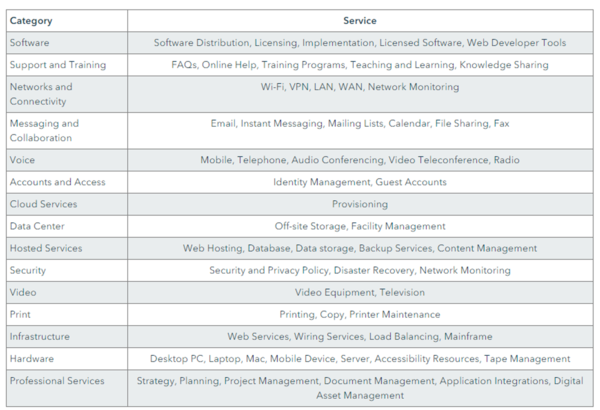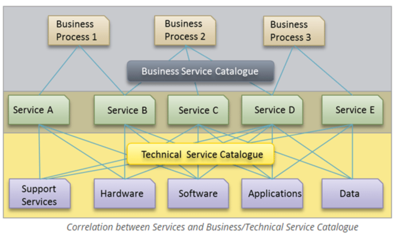Service Catalog
What is Service Catalog?
An ITIL Service Catalog (or Service Catalogue) is the single source of accurate information on all IT services offered by an organization's IT department. ITIL defines a service catalog as a centralized database of accurate information about active IT service offerings, and a subset of the IT service provider's service portfolio. In simpler terms, it is the storefront from where end users (internal or external) request services and products from the IT service desk based on the information provided in the service catalog.[1]
mDeveloping a Service Catalog[2]
Developing a service catalog may sound simple, but in order to encourage customer engagement and set proper expectations, it helps to consider the following tips to make it work:
- Identify the services your business needs in order to operate: Developing a service catalog is an exercise in good communication. Know your company and learn about its wants and needs. Business unit managers and other decision-makers should work with both end users and stakeholders to determine what they need to perform their jobs. Differentiate between the services that your service desk and other IT teams currently provide and what may be missing. Are they essential and, more importantly, do they align with company goals?
- Define security and access permissions: Who will have access to the service catalog and specific services? Restricting access to the service catalog or specific services is important. You may want to allow end-users to request a keyboard or mouse, but limit items with a higher price tag, such as laptops or tablets, to management.
- Simplify the search process: Categorize services with your end user in mind. Simplify whenever possible and keep technical jargon to a minimum. For example, would a business user know to look under ‘infrastructure’ for backup services, or should ‘backup’ be front and center? Think about the intuitiveness of Amazon categorization. Confusion creates dissatisfaction, and dissatisfaction will defeat the purpose of your service catalog.
- Optimize the user experience: Make the user experience a friendly one with an easy-to-access, simple-to-navigate IT self-service portal that contains all of the services that they will need to do their job.
- Roll out in phases: Test a representative portion of your user pool with a small selection of services. Find out what works and what doesn’t. Solve the “glitches” and slowly increase the user base and offerings within your catalog.
- Invest in automation: Once you feel confident in the design of your service catalog and processes that support it, select a software product that best manages your company’s specific service needs – and automate delivery whenever possible.
The figure below illustrates where the Service Catalog fits in the Service Lifecycle.

source: ITIL News
Service Catalogue - Different Approaches[3]
Practically, there are two kinds of Service Catalogue for a Service:
- Business Service Catalogue. If we are considering (potential) customers and what we offer (our Service Catalogue), then we are talking about Business Service Catalogue. Services that we offer are written in clear, easily understandable (as much as it is possible) or, as we like to say, business language. Usually, that is a hard job to do as well is a reason why it is hard to establish a Service Catalogue for an organization. Sometimes I find that people involved in the development of a Service Catalogue are too technical, and the result is that the Service Catalogue is written too technical; but, if they do not have technical knowledge, it is hard to understand a detailed description of a service (which is a prerequisite to making a short and understandable summary).
- Technical Service Catalogue. On the other side, Services have a lot of technology in their backgrounds. A technological solution has to be documented and explained in detail: that is the Technical Service Catalogue. It is written in technical language and is not intended to be published outside of the IT organization, i.e. customers don’t need to have access to such a document. Its value is in defining end-to-end service from a technical point of view.
What usually happens is that organizations have a Business Service Catalogue, but rarely have a Technical Service Catalogue. Typically, the Technical Service Catalogue is usually presented via the functional specification of a service. If there is no other possibility, that is okay, but the Technical Service Catalogue should also contain information from other processes of a service lifecycle (e.g. Service Level Agreement data from the Service Level Management process).
Typical content of a Business Service Catalogue includes deliverable description (services that we are offering, written in business language), service level parameters, costs, maintenance description, information about related services, description of the value that is provided to the customer, etc.
The Importance of Service Catalog[4]
The use of a Service Catalog helps IT departments reduce the cost of service delivery and increase the level of user satisfaction. Using a Service Catalog integrated with Request Fulfillment provides several benefits for the entire organization among which are these top 10:
- Centralized Management of Request via Service Catalog: Whether a user needs to request access to an application, retrieve a backup, or purchase new equipment, the Service Catalog is the access point to all products and services offered by IT or other departments, providing access to this information and how it is processed.
- Simplicity for the user: The users request what they need and they receive it without worrying about the process of providing the service
- Self-service: The use of a Service Catalog greatly facilitates user self-service capabilities, reduces management costs, and improves the user experience by providing detailed information about their requests (description, price, delivery, approvals, etc.) and the status of their application.
- Improvement in business processes: Each product or service can have its own process of processing, based on the data provided by the user. It is not the same to process the registration to training as processing the provisioning of a PC.
- Better control: One of the main needs of any IT department is to have maximum control over the entire operation. The use of a Service Catalog with the Request Management process allows traceability of the entire process from application to delivery recording and documenting all the intermediate steps.
- Standardization of supply: An important benefit of using a Service Catalog is the ability to provide each user with complementary products and services, like eliminating the possibility that someone who should not have access to an application, could apply the access to it, simplifying the Catalog for each user profile and reducing the workload by eliminating the processing of improper applications.
- Cost reduction: Good Service Catalog reduces the time that the user requires to process applications, allowing these applications to be processed more efficiently and also letting the most qualified IT staff focus on those tasks that bring more value to the organization, reducing total operating costs.
- Improvement in financial management: Centrally processing all requests through the Service Catalog facilitates the allocation of costs associated with each corresponding department or business. Besides, knowing the price of each product or service offered, allows each area to make its budgets more accurately.
- Increase user satisfaction: Provide the user with a single point where to see everything that IT offers, where to can send your requests, and always know the state of the same, not only improves the management of service delivery but also greatly increases the satisfaction of the user.
- Maximize business benefits: An IT Service Catalog describes each service not only by its characteristics but also by its objectives. This intelligence helps closely align IT services with the business strategy, substantially contributing to the achievement of corporate goals
See Also
ITIL (Information Technology Infrastructure Library)
ITIL Availability Management
ITIL Continual Service Improvement (CSI)
ITIL Event Management
ITIL Facilities Management
ITIL Problem Management
ITIL Service Delivery
ITIL Service Design
ITIL Service Lifecycle
ITIL Service Strategy
ITIL Service Operation
ITIL Service Value Chain (SVC)
ITIL Service Value System (SVS)
Service Portfolio Management
Service Portfolio
Service Catalog


